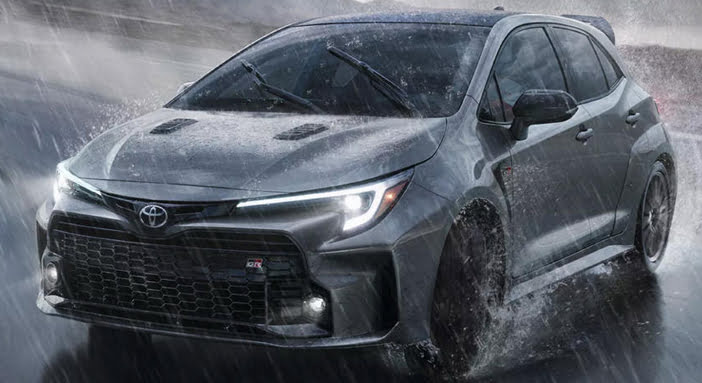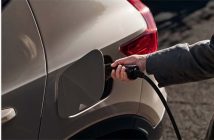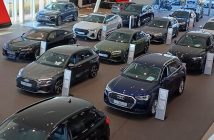+++ The ALFA ROMEO Guilia and Alfa Romeo Stelvio will gain a new, range-topping Estrema specification at the end of April, which Turin says emphasises the focus on dynamics and refinement. Estrema is the firm’s first global special series and adds a host of technical upgrades as standard. Basic kit on both the new saloon and SUV include active suspension, chassis domain control and a mechanical seal-locking limited-slip differential. The 2 cars also gain some exterior design changes that Alfa Romeo says provides “more lightness and a sporty attitude”. These include carbonfibre for the door mirrors and front grille, dark colours on the wheels and brake callipers and Estrema badging. The Guilia is fitted with 19 inch alloys, while the Stelvio receives a 21 inch set. Inside, Alcantara seats come as standard, as does red stitching on the steering wheel, seats, dashboard and gearstick. There’s also a 14-speaker Harman Kardon sound system. Buyers have the choice of either a 2.0-litre 280 hp 4-cylinder petrol engine or a 210 hp 2.2-litre 4-cylinder diesel engine. Both are mated to an 8-speed automatic gearbox and 4-wheel drive. The 2 models were unveiled at the Alfa Romeo Formula 1 team’s headquarters in Hinwil, Switzerland, which the firm said was ideal because it’s a “breeding ground for new technology”. Alfa Romeo’s partnership with Sauber Motorsport is also said to have helped the new models embody the “highest achievements in terms of technical and dynamic solutions, style and sportiness”. Prices for the Estrema variants are yet to be revealed, but expect them to command a premium over the current, range-topping Veloce specification shared by both models. +++
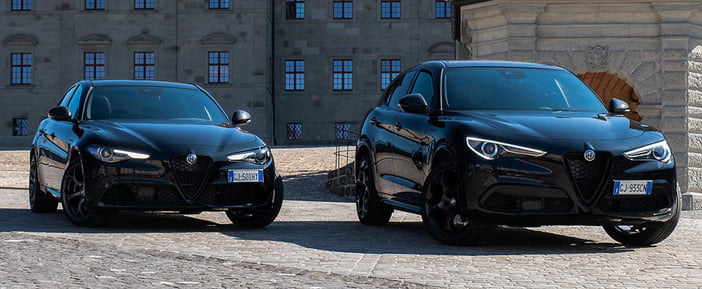
+++ ALPINE ’s upcoming electric cars will draw heavily on engineering from its Formula 1 team as the marque seeks to optimise efficiency while reinforcing its enthusiast-targeted brand positioning. Three all-new Alpine EVs will be launched over the next 4 years, meaning Dieppe requires expertise in electrified powertrain technology and, in order to maximise range, aerodynamics, which is in abundant supply at the UK-based race team. “The A522 aerodynamics group at Enstone has just finished a particular project for Alpine road cars, and we’re about to embark on another”, Alpine F1 technical director Matt Harman told as the all-new ground-effects racer began testing. “We’re linking those 2 groups of people together, both in physical testing and in computational fluid dynamics. It’s a really nice collaboration, and it’s good for the aerodynamicists, giving them another angle to look at, freshening their minds. They really enjoy working on those projects, so we will keep them going. In fact, we will probably expand more of our engineering expertise into the road cars”. The recently completed project was the Alpine version of the reborn Renault 5 supermini, expected to launch in 2024. The next project is most likely a low-slung crossover, the Alpine GT X-Over, due in 2025, which will be followed by an A110 sports car replacement, developed with Lotus. Alpine CEO Laurent Rossi told: “We want to ride the wave of F1. We’re really making technology transfer in the battery management system, because whether you have a hybrid in F1 or an electric car in the street, it’s really exactly the same today. It’s about when you can release electricity that you convert into instant torque; how much time can you do that around a track or along a road; how much of the battery charge you can recover; and how long you can make it last for range. All of this is the same. We transfer learnings about electricity from track to road and from road to track. Aero also becomes an element, because we can now announce range on a road car thanks to the aero. These are all important things we’re going to use for mass production”. Harman concurred: “There’s a great deal of transfer, specifically in the motor generators; that’s the MGU-K in F1. The development and technology inside those units is improving massively. Also the battery technology and how we manage the battery thermally. We would all like to have EVs, but we worry a bit about the range of them generally, and range is only going to improve with that development. Those are the things you should watch on the car over the next couple of years. It’s going to be an area where we really push”. +++
+++ BAIC Bluepark’s premium marque ARCFOX is expected to see its sales reach 40.000 units, up from 6.000 units in 2021, said senior executives at the Shanghai-listed subsidiary of State-owned BAIC Group. The ambition for this year and its structural adjustments done in 2021 have driven the price of the company’s shares to a limit up on Monday. If Arcfox can hit the sales target, it is likely to further drive the carmaker’s business recovery, said analysts. BAIC Bluepark, which owns Arcfox and Beijing marques, saw its operating revenue hit 8.70 billion yuan ($1.37 billion) last year, up 64.95 percent year-on-year, according to its financial statements released on Saturday. Its net loss attributable to shareholders was 5.24 billion yuan, 1.24 billion less than in 2020. Its cash flow in the year stood at 4.98 billion yuan. Arcfox now has 2 models in the market. A Huawei Inside version, which is powered by the technology giant’s chips and autonomous driving solution, is to boost drive Arcfox sales this year, said Dai Kangwei, president of BAIC Bluepark. She said its sales surge will bring BAIC Bluepark’s total deliveries to 100.000 units this year. The Beijing marque, which produces and sells more affordable gasoline and electric vehicles, is expected to see its sales reach 60.000 units. Dai said the company will launch 2 sub-compact Arcfox models in 2023, which will further enrich the marque’s lineup. They are based on the platform the company has developed with Canadian auto supplier Magna. “Now we are launching 1 model every 6 months or even less. We can develop more models on this platform”, said Dai. Last year, it spent 1.21 billion yuan in research and development, up 24.14 percent year-on-year, to sharpen its technological competitive edge. Arcfox president Wang Qiufeng said the brand’s sales network is growing fast, with the total number of dealerships to reach 186 by the end of this year, up from 86 in 2021. Wang said more and more car buyers are turning their back on gasoline vehicles, with seven major cities seeing electric cars and plug-in hybrids accounting for over 16 percent of total vehicle deliveries last year. China sold 3.5 million electric cars and plug-in hybrids in 2021, up 160 percent year-on-year, according to the China Association of Automobile Manufacturers. The association estimated their deliveries to grow further to reach 5.5 million this year.
+++
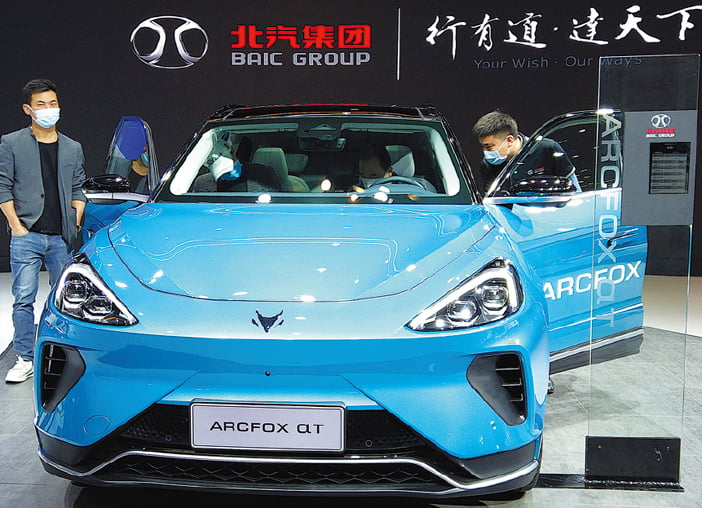
+++ ASTON MARTIN is pushing ahead with plans to strengthen its image as a bona fide British rival to Ferrari and is readying an entry-level supercar with a mid-mounted V8 to take on the new Ferrari 296 GTB. It will be the third addition to Aston Martin’s mid-engined supercar line-up, following the launch this year of the Cosworth V12-engined Valkyrie hypercar and the 2024 launch of the V8-powered Valhalla. The trio were shown together for the first time at the Geneva motor show in 2019, but Aston has since undergone a dramatic process of reinvention under new management and ownership, with the evolution of the Valhalla production car testament to a shift in priorities over the coming years. Like the Valhalla, the entry-level mid-engined supercar (originally called the Vanquish but likely to drop that name, according to company chairman Lawrence Stroll) is expected to be a radically different proposition by the time it is revealed in its final form. Chief among the changes is set to be a switch from Aston’s own V6 petrol engine to a 4.0-litre twin-turbo V8 supplied by majority shareholder Mercedes-AMG. The V8 will be paired with an electric drive unit to form a plug-in hybrid system that will rival today’s most powerful supercars for outright potency. The Valhalla, which straddles the boundary between supercar and hypercar (and thus commands a price of around €1.300.000 in the Netherlands), uses the most highly strung version of AMG’s M178 V8, as featured in the hardcore Mercedes-AMG GT Black Series, with a flat-plane crank and a 7.200 rpm redline. In keeping with its entry billing (and a price expected to be nearer the €500.000 mark) the less potent Aston is more likely to use the engine in the same state of tune as the Mercedes-AMG GT 63, for a pure-combustion output of around 630 hp. Aston has already confirmed hybridisation across all of its platforms by 2025, so the new supercar could supplement its reserves with a 204 hp electric motor on the rear axle, like the PHEV version of the GT 63. This would give a combined output of 840 hp, slotting the new model neatly between the Aston Martin DBS and Valhalla on outright power. Last year, Aston ended development of its own 3.0-litre V6 engine, which was ultimately set to be rolled out across its line-up, as part of a wide-reaching rationalisation programme under CEO and ex-AMG boss Tobias Moers. The new supercar will therefore be reworked to accommodate the larger, more cost-effective German engine, as was the Valhalla, but will remain true to its lightweight and dynamically focused conception. Built around a carbonfibre tub for an optimal combination of rigidity and lightness, the new arrival should tip the scales at less than 1.500 kg, given the more highly strung Valhalla weighs just 1.550 kg, while a Valkyrie-inspired aero package will maximise downforce and promote high-speed cornering agility. For reference, the Valhalla’s airflow-enhancing bodywork elements (including gaping venturi tunnels running from front to rear and an active front splitter and rear wing) generate 600 kg of downforce at 240 kph. However, the overall package is expected to be as road-focused and generously equipped as its rivals, with a dual focus on driver-oriented ergonomics and long-distance refinement. Importantly, the supercar will benefit from Aston’s transition to a new generation of touchscreen infotainment, which will be the headline upgrade for its facelifted front-engined sports cars (Vantage, DBS and DB11) at the end of 2022. +++
+++ AUDI is readying an all-new third-generation version of its bestselling global SUV model, the Q5, which will be one of its final ICE cars. In 2021, global sales of the Q5 soared by 5.3% to 293.069, representing nearly a sixth of Audi’s total deliveries. It remains vitally important for the German brand 5 years on from being launched in its current form. The next iteration, which has started winter testing ahead of an anticipated 2023 unveiling and 2024 market launch, will look to maintain that sales momentum by providing a conventional ICE alternative to the similarly sized electric Q6 e-Tron, which will arrive next year. The new Q5 is expected to use the same evolution of the Volkswagen Group’s MLB architecture that will underpin the next-generation A4. That means it will offer both front and 4-wheeldrive drivetrain layouts and is likely to continue with a familiar powertrain line-up comprising mild-hybrid petrol and diesel options alongside a choice of plug-in hybrids. The engines will be re-engineered to meet new Euro 7 emissions regulations, expected to be implemented in the coming years. One of these will be the fifth version of the Volkswagen Group’s 2.0-litre four-cylinder turbo petrol EA888, which will receive a revamped fuel-injection system and new particulate filters. The modified platform also introduces capacity for the Q5 to use the 4-wheel steering system featured on the A8 and Q8, as well as level 2 autonomous driving functions and a raft of new connectivity features. At this stage, the most obvious differentiator between this new Q5 and the current car is a completely new look that brings it into line with its newer stablemates, including the electric E-tron models. Details visible through the camouflage on this prototype include a totally overhauled front end with a clamshell-style bonnet, a shorter grille, sleek new headlights and new air-intake designs. At the rear, meanwhile, the Q5 looks to have been modelled on the Q4 e-Tron, although the brake lights in situ here look to be temporary items for the purposes of testing. As with the current Q3, Q4 e-Tron, Q5 and e-Tron SUVs, the new Q5 is expected to be sold in straight-backed standard and rakish-roofed Sportback guises. Audi will use the new PPE platform, which it’s co-developing with Porsche, for new electric versions of the A4 and A6, but given the new Q6 E-tron will essentially serve as an electric alternative to the Q5, the latter is unlikely to get an EV option. Audi has committed to only launching EVs from 2026 and will stop selling ICE cars completely in 2033, meaning the Q5 is likely to be among the final ICE cars the brand sells. However, Audi has also said that it plans to keep an ICE version of the A6 on sale alongside the new electric A6 e-Tron, hinting at a gradual shift towards all-out electrification for all models. +++
+++ The BMW 3 Series has been given an electric powertrain for the Chinese market, where it will be sold under the i3 name. The new model, based on the long-wheelbase Chinese market version of the traditional sedan, is planned to go on sale in May, shortly before the 9 year old i3 electric hatchback bows out of production. It will be launched in rear-wheeldrive i3 eDrive35L guise, which is claimed to provide a range of up to 520 km on the Chinese Light Duty Test Cycle. Drawing on developments brought to the Chinese-built iX3 that arrived in 2021, the new i3 eDrive35L has a single electric motor. Sited at the rear in a new electrified axle assembly, it develops the same 292 hp and 400 Nm as it does in the rear-driven iX3. Energy for the motor is provided by a 66.1 kWh (net) lithium ion battery pack using cells provided by the Chinese company CATL. Mounted in a modified version of BMW’s CLAR platform structure, it can be charged at rates of up to 11 kW by an AC charger and up to 95 kW by a higher-powered DC system. The charging time from 10-80% is put at 35 minutes. By comparison, the iX3 uses a larger 74 kWh (net) battery that can be charged at up to 150 kW. BMW claims a 0-100 kph time for the i3 eDrive35L of 6.2 seconds. An official top speed hasn’t been announced, but BMW officials suggest it will be limited to the same 180 kph as the iX3, as is common for Chinese-market models. The i3 eDrive35L is based on the Chinese-market 3 Series L, which has a wheelbase 115 mm longer than that of the standard model sold in other markets, extending its overall length to 4872 mm. Inside, the new i3 receives BMW’s eighth-generation iDrive infotainnment system and what BMW describes as a “wide range of cutting-edge digital features and services making their 3 Series debut”. The packaging of the battery and power electronics reduces boot capacity over standard petrol and diesel versions of the 3 Series by 80 litres, at a claimed 400 litres. This is 25 litres more than that offered by the BMW 330e plug-in hybrid. The new i3 is the second electric BMW model to be produced in China after the iX3. Like its SUV sibling, the new four-door model is produced in a joint venture between BMW and Chinese car maker Brilliance in an operation called BMW Brilliance Automotive, headquartered in Shenyang. +++
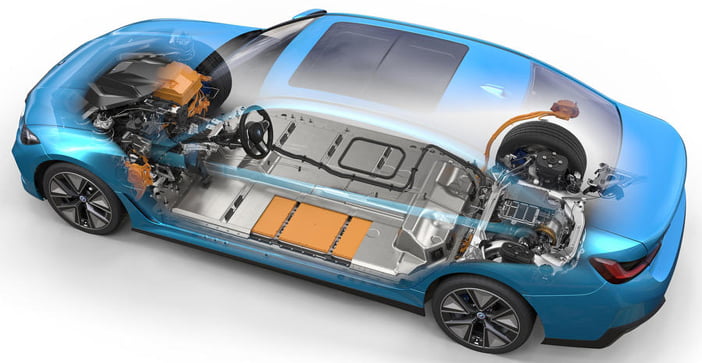
+++ In CHINA, competitive electric cars led to explosive growth of the NEV sector last year, Xu Changming, deputy director of the State Information Center, said. NEV sales soared 156 percent to 3.27 million units in 2021. In the first 2 months of this year, the sector jumped 141 percent compared with same period last year. In 2020, NEV sales accounted for 6 percent of total auto market. The figure increased to 15.7 percent in 2021 and 19.2 percent over the first 2 months of this year. The jump is due to NEVs that can compete with gasoline cars, including the Tesla Model 3, Tesla Model Y, Wuling Hongguang Mini EV and BYD DMI, Xu said. Local production has cut the prices of Tesla models, making them competitive compared with models from Mercedes-Benz and BMW. The Model 3 and the Model Y are also driving sales of domestic high-end NEVs and bolstering their acceptance among car buyers. The Wuling Hongguang Mini EV is an example of competitively priced vehicle in the lower-end market, which is around 30.000 yuan ($4,700). Xu added that the NEV sector will show rapid growth for a period in the future, but its relationship with traditional cars is competitive rather than alternative if there is no breakthrough in battery technology. +++
+++ Automakers are actively pursuing the development and mass production of E-AXLES , a core drivetrain part for electric vehicles. The eAxles are seen as the heart of EVs and have a significant impact on their electrical efficiency and performance. In addition to major auto parts makers in Japan and abroad, an increasing number of companies in other business sectors are also entering the market for eAxles, which may lead to significant changes in the competitive landscape of the automobile industry. An integrated drivetrain part, eAxles unify the motor, gearbox and inverter, which controls the electric current. By integrating these major parts, automobile manufacturers can save time and labor on development and assembly, their EVs can be lighter, and costs can be reduced. Aisin president Moritaka Yoshida stressed: “We regard eAxles for EVs as a top priority and will concentrate our business resources on further development”. Over a 2-year period starting in fiscal 2022, Aisin is assigning most of its engineers to work on electrification and intends to strengthen its development framework. This was prompted by concerns that the market for automatic transmissions for gasoline-powered cars, which are currently Aisin’s main products, may shrink amid a shift to EVs. Aisin developed its first generation of eAxles in 2020. They were installed in such models as Toyota’s Mirai fuel-cell vehicles. Aisin plans to accelerate its development, enhancing its eAxle’s energy efficiency, reducing its size and lowering costs. The company aims to develop second-generation products that can be used in compact, midsize and large vehicles in 2025, and to begin mass production of third-generation products in 2027. Aisin also seeks to build new production lines in Japan in the near future. Through such means as improving its eAxle, Aisin is hoping to raise EVs’ driving range by at least 10%. Group efforts The eAxles are core elements that affect the basic performance of EVs and are as critical as the batteries installed in such vehicles. Experts liken them to the engines of gasoline-powered cars, and eAxles can affect acceleration and travel distance. Because the motor, gearbox and inverter are integrated inside, eAxles reduce the weight of EVs and allow more body space. Toyota and its group companies are therefore enhancing their development framework. In 2020, Toyota contributed capital to BluE Nexus, a company developing and selling eAxles that was jointly established by Denso and Aisin. BluE Nexus coordinates between automakers and parts makers regarding the design and performance of eAxles. Toyota is scheduled to soon release its first mass-production EV model, the BZ4X, on the global market, and plans to install newly developed eAxles from BluE Nexus. Aichi Steel announced a prototype of its eAxle in February. The company signed a cooperation agreement with Tohoku University, and it aims to develop technologies and materials that enable eAxles to rotate at higher speeds and become smaller. Aichi Steel president Takahiro Fujioka said: “We’re still in the development stage, but Aichi Steel has lots of expertise regarding parts”. Competition heating up Market research firm Fuji Keizai predicts that the number of electric-powered vehicles containing eAxles, including EVs and hybrids, will soar to about 12.5 million in 2035, or 54 times the about 230,000 in 2019. Competition among related companies has grown increasingly fierce to take advantage of this demand. Jatco, a Nissan subsidiary that produces transmission parts, is conducting research and development for the mass production of eAxles. Hitachi Astemo is also considering their development. The company was established in January last year through the management integration of parts makers that were subsidiaries of Hitachi and Honda. Top overseas suppliers, such as Bosch of Germany, have also thrown their full energy into mass-producing the parts, and companies in other business sectors have entered the eAxle market as well. Nidec began providing eAxles in 2019, ahead of other companies, drawing on its processing techniques for motors. Ten car models from automakers in China, where EVs are more common than in Japan, are already equipped with Nidec’s eAxles. Operations will begin in the middle of this year at its plant in Serbia, its sixth production base in the world. Mitsubishi Electric announced in November last year that it will enter the eAxle market in cooperation with other companies. It aims to mass-produce the parts in the near future. +++
+++ GREAT WALL saw its operating revenue reach 136.4 billion yuan ($21.46 billion) last year; up 32.04 percent year-on-year, said China’s largest SUV and pickup maker. Its net profit rose 25.41 percent to hit 6.7 billion yuan in the same year, despite the chip shortages that has been hitting the global automotive industry since late 2020. Great Wall Motors has made progress in its efforts to move upward to take on international automotive brands. The average price of models at the Baoding, Hebei province-based carmaker reached 100/600 yuan last year, up 15.02 percent from 2020. In the first 2 months this year, models priced over 150.000 yuan accounted for 15.5 percent of its total sales, said the carmaker. GWM said this is partly attributable to its focus on research and development. Last year, it spent 9.07 billion yuan in R&D, which accounted for 6.65 percent of its operating revenue in the year. +++
+++ Michael van der Sande was appointed managing director of JAGUAR LAND ROVER Special Vehicle Operations in 2018, having previously held senior positions at Alpine, Renault, Aston Martin, Tesla, Harley-Davidson, Bentley and Nissan. Here, he talks to us about how SVO sits within the wider JLR business, its main areas of operations and his excitement for the future as the firm moves to a more high-end position and the industry transitions towards electrification. Queston: Can you explain Special Vehicle Operations for us? Answer: “We tend to do the cool stuff that doesn’t fit into a large, more volume-based manufacturing process and that really leverages the emotional connection between the customer and the car to do something even more special. We have 4 activities within that. The first one is our SV-badged cars, which are the high-performance and high-luxury Land Rovers and Jaguars, then there’s our vehicle personalisation business that basically does anything to add more content and value to an existing model, from accessories to armoured cars. Then there’s our classic division, where we restore cars and we buy and sell very high-quality examples of classic cars. We have more than 70 years of history in both brands, so there’s a lot of cars on the road that we try and support with parts, expertise, technical knowledge and so on. And we build continuation cars in very low volumes, like C- and D-Types, XKSS and so on. And, finally, more recently, we purchased Bowler back in 2019. And in a few weeks time we are kicking off our Bowler Defender Challenge race series, initially in the UK. We’re a business within a business and we tend to look at the more niche, really high-end, really sporty, really off-road activities that you wouldn’t put through a mainstream development or manufacturing process”. Q: How do you take a modern Jaguar or Land Rover and make it into an SVO vehicle? A: “We have a slightly different strategy than most of our competition in that we dial up the content of the car to 9, 10 or even 11 sometimes depending on how crazy we want to go. But rather than making everything sporty, we try to remain faithful to the underlying character of the car. “So, as you know, we’ve just launched the new Range Rover SV, which adds a lot of more luxury into an already luxury SUV. The Range Rover is already fantastic, of course, but there’s always a customer that wants that little bit more content, more personalisation, more materials, technology, more performance, whatever. What we do is basically dial that up as far as we possibly can. And the Range Rover SV is a perfect example of that. “Interestingly, technology is enabling merging of segments and these days you can have a luxury car that’s also sporty or a sporty car that’s also luxury. The technology allows us to dial different attributes up at the same time”. You mentioned bespoke there. Can anyone enlist the services of bespoke creating their own Jaguar Land Rover vehicle? “We do not offer bespoke services on every model and every trim level yet but that’s just a matter of scaling. We are starting at the top end because that’s where the pricing power is. But we do try and satisfy everybody’s wild and not-so-wild requirements for personalisation. Customers will want to make the cars their own and sometimes the request is relatively simple, such as a special paint job that goes with either another car they’ve got or the colour of their favourite handbag or the colour of their favourite necktie or whatever. “More extreme requests do come in. One that we didn’t fulfil was a customer that asked us to imitate the accent of our previous CEO in the car. We thought that was a bit much. So we do draw a line somewhere but we try and fulfil pretty much every wish”. Q: Can you describe the essence of Jaguar Land Rover Classic? A: “Classic for me, our team and a lot of customers is a real source of passion and excitement because, ultimately, no luxury or premium or sports car brand lives in isolation. It’s an amalgamation of your stories from the past, whether it’s Land Rover creating a segment or Jaguars winning Le Mans in the 1950s. There’s a backstory that creates context and authenticity to what we do in the future. So it’s a really good way of telling stories about the brand. “That doesn’t mean we’re looking over our shoulder or looking in the rearview mirror: we’re not retro. However, in those stories from the past, there’s a lot of opportunity for us to provide context, provide relevance and, frankly, for customers to enjoy those old cars. And that’s why we’re treating it as a business activity, not just as a marketing activity. Back to top “So we source the best cars and sell them with good warranties. We restore the best and most exclusive cars. We just completed 12 very high-value restoration E-Types to celebrate the 60th anniversary of the car. It’s really a business within the business that curates the stories of the past and supports owners of existing classic cars, helping to keep those cars on the road with knowledge, parts, servicing and so on. We’re custodians of the past acting in the service of the future”. Q: What are your favourite projects? A: “Well, we obviously have our very high-end customers that want to spend quite a lot of money either buying a C-Type or restoring a E-Type and really making it their own but it’s not just that; we also had a customer who came in with a rather ropey XK8, which is a more recent classic that wasn’t worth very much. It was not in good condition. This customer had had that car since new, it was the car in which he picked up his newborn son from the hospital, so he wanted that car restored back to its original condition. He didn’t want us to go and source a better one. It was absolutely economically crazy to do it, but that car had a lot of emotional value for that customer. So we gave him a restoration to a brand-new standard. It’s not just technically brilliant work; it can be incredibly emotionally rewarding too”. Q: What is a continuation car and what makes it special? A: “Some of our back-catalogue cars have now become so valuable that they’re difficult to use on a regular basis. So we’ve had both existing owners of those iconic cars and owners who want one but who are put off by the £5 million £20 million valuations on them. So we try to faithfully recreate not just the car but also the engine. And really we create the feeling of that car in a usable way. “Each car is 2.000-4.000 hours of work so they’re expensive, and as a result very exclusive, but we feel there’s a market for it and they’re fantastic opportunities for us to tell the story of what happened back in the 1950s”. Q: What about restomods? A: “What would break my heart was to take a very rare car and chop that up and turn it into something that’s not original. However, if you look at more recent or more mundane cars, of which there are many still running, I actually think the restomod movement is very interesting. In a way, our Defender V8 Trophy programme, which uses 8 to 10 year-old cars, is an example. We’ve decided to upgrade and re-engineer that car, to put in a modern V8 engine, upgraded suspension, upgraded brakes and so on to turn it into something special, the best Defender of its type there can be. Sometimes we run that as a programme and we will do 20 or 30 of them. Sometimes it’s a one-off where somebody has a very specific idea of what they’d like the car to be. Where we draw the line is basically chopping up and changing an iconic car that has so much historical value in itself that we feel we can’t touch it”. Q: What about electromods? A: “You’ll recall we did an E-Type concept car 4 years ago. We chose at the time not to productionise that; it’s not difficult to electrify a car but it is difficult to do it safely. You’re working with 400 Volt and you don’t want to either create a fire hazard for the car itself or set the mechanic’s hair on fire, so we put the programme on hold at the time. Also, the economics a few years ago just didn’t make it feasible as a business proposition. However, we’re constantly monitoring that. If we get involved in that, we need to do it right. Maybe one of these days, but not yet”. Q: Can electrification give you new avenues to explore with modern vehicles? A: “We absolutely are in the process of electrifying everything. I think that’s the right thing to do. It’s where the market is headed and, frankly, in the context of CO2 and global warming, it’s what we need to do and what we want to do. So it is up to us to define what a great electric vehicle looks like. I see opportunities in electrification: it makes it even more feasible to combine different attributes, because an electric car is both comfortable and fast, for example, in a way that a V8 car can’t be. There are opportunities to merge segments and have attributes that are very attractive on multiple axes. Then dynamics offer lots of opportunities to differentiate ourselves from the competition and from our own main business, through things like multi-motor solutions, tuning, torque vectoring and so on. There are many technical solutions that allow us to do things that are special. Clearly, when we bring out our first SV electric car, we want that car to be as emotionally attractive as a current internal combustion-engined car, and we’re on that path. I can’t talk to you about the specifics yet, but I’m very excited about the electric future”. Q: What about sound specifically? How do you replace the roar of a V8? A: “Let’s be honest: I love my V8. But that sound is going to go away in time: Jaguar is moving to fully electric from 2025, so that’s not far away. Is a future electric Jaguar Land Rover going to sound like a V8? No, probably not. I don’t think that’s an authentic way of doing it. “But sound is a critical part of experience. So we are thinking through what that means”. Q: Do you go completely quiet or do you look for more synthetic sounds? A: “We haven’t decided the answer yet. Yes, I’ll shed a tear or two when we make our last supercharged V8, but that’s a bit of time away yet. I think that it is perfectly possible to build a highly emotional car without the V8 sound, but I think the whole industry is working its way through what that means and how we manage that”. Q: What kind of buyers are choosing Defender commercial vehicles? A: “We’ve had the Land Rover Discovery commercial vehicle for a number of years, mostly sold in the UK but also increasingly around the world. Clearly there’s a tax benefit to running that as a company utility vehicle. But the good news is that the attributes of the car otherwise remain unchanged. So while you don’t have rear seats and a bulkhead, it still drives like a Discovery. Now we’ve also done that for Land Rover Defender Hard Top. Frankly, when we launched it about 18 months ago, demand just ran away with us. And in this past year of semiconductor shortages, we’ve not been able to build fully to the demand. We’ve exponentially increased the number of cars to a number of 1.000s this year but we could have built a lot more. It’s a luxury version of a utility vehicle; it’s the high end of the of the Commercial SUV market”. Q: Where does Bowler fit in? A: “Many of us who have been around the car business have seen, admired and enjoyed the various exploits of Bowler over the years. It is a very small company: when we acquired it 2 years ago, it was only 23 people in a small facility in Derbyshire, but they did fantastic things through their conversions of Defenders. From a capability and brand point of view, they have always punched beyond their weight, but for various reasons since Drew Bowler, the founder, died 6 years ago, it never was able to scale up. We’ve focused our efforts on creating a new version of the Defender Challenge. 7 or 8 years ago, Bowler and Land Rover launched the original Defender Challenge with the old Defender. That was a relatively small programme, very UK-based but popular. What we’re creating this year, with the new Land Rover Defender, is an entry-level off-road race programme. Our intent really is to rekindle that spirit of grassroots racing, then decide whether they’re happy with that or go to more competitive classes higher up in time. “We see that business as a small but critical part of our operation to really exploit the off-road capability of the Defender. It’s a relatively light conversion of the car, but it can do amazing things and we’re looking forward to enjoying that in various markets in future”. Q: What’s next? It’s a year since Jaguar Land Rover announced its ‘Reimagine’ strategy about the future of the business. A huge part of which was around Jaguar Land Rover models going upmarket becoming even more luxurious. That seems to fit in really neatly with SVO. A: “We defined the strategy for SV ahead of the Reimagine strategy, but I was very pleased to see what CEO Thierry Bolloré is doing with the broader company strategy aligning perfectly with our mission at SVO. My view is that when Land Rover and Jaguar move further upmarket, there’s always going to be a super-premium or super-luxury customer that wants that little bit more personalisation, performance, off-road capability, luxury, whatever it is. So it plays right into our hands. I think it’s going to deliver us even more customers to grow what we do in conjunction with our main business”. Q: You’re clearly excited about the future with electrification. What kind of possibilities does that open up for you? A: “I can’t give details of course but, yes, it opens huge opportunities for segment-busting cars combining different technologies seamlessly. “Take off-road capability as just one example. One of the facts is that an electric car can be much more precise in powering individual wheels than an internal combustion engine. That’s one way electric will open up that we’re looking into. It has huge advantages in some areas. I’m excited and I believe people will still be excited by cars long into the future as a result”. +++
+++ Total global output by the 8 major automakers from JAPAN in February rose for the first time since June 2021, up 3.6 percent from a year earlier to nearly 2.01 million vehicles, due to the waning impact of a global semiconductor crunch, industry data showed Wednesday. A recovery in overseas production also helped lift the global output for the automakers including Toyota and Honda, according to the data. Of the 8 companies, 5 saw their February global output rise compared with the previous year. Toyota’s global output rose 10.9 percent to 740.996 units, aided by its robust overseas production that grew to the largest for any February. Honda, supported by robust production in China and Thailand, saw an 8.1 percent increase to 344.712 units. Daihatsu, the minivehicle-making subsidiary of Toyota, logged a 10.2 percent increase in global output to 149.371 units. In contrast, Nissan saw a 7.8 percent decrease in global output from a year earlier to 275.437 units, as did Subaru, which saw a 23.6 percent fall to 47.625 units. The 2 automakers along with Mazda reported a decline in output due to reduced overseas and domestic production, impacted by the global semiconductor shortage. Domestic output, however, continued to decrease, with the outlook for the auto industry uncertain due to the impact of the war in Ukraine following Russia’s invasion. Total domestic output by the 8 major automakers was down 1.6 percent to 656.195 units, hit by the difficulty in procuring semiconductors for hybrid and other electric vehicles, the industry data suggested. Overall global sales declined 4.5 percent to 1.832.694 units, the data said. Toyota in February lowered its global production plan for fiscal 2021 from 9 million units to 8.5 million units. The company is unlikely to reach its production target of 950.000 units in March. +++
+++ Technology showcased on the super-efficient MERCEDES-BENZ EQXX concept will make production, a spokesman has confirmed. He said that technology featured on the car, as well as processes adopted during its super-quick 18 month gestation, will filter through to mainstream models. “Our EQXX is a research vehicle designed to push boundaries and explore options for future production vehicles. It is a blueprint for series production. Many innovations from this technology programme will soon find their way into our production vehicles”, they said. “As well as specific components and technologies, this includes the highly agile, multi-disciplinary development approach as well as the software and digital tools used during the development process”. The EQXX concept was unveiled in January, and is claimed to set new energy efficiency benchmarks to get a “real-world range of more than 1.000 km”; 270 km more than the EQS flagship EV. The rakish compact saloon is the latest in a long line of design studies made public by Mercedes-Benz. It has been conceived to challenge existing EV principles in a programme aimed at hatching new ideas, processes and innovations for adoption on upcoming EVs. At its reveal, Mercedes chief technology officer Markus Schäfer noted that the concept was a running and driving protoype, which even uses a version of the existing MBUX infotainment system, hinting at its production intent. However, the latest comments made to Move Electric are the strongest yet in regards to the technology’s production potential. “There are many, many elements of the vehicle which are very close to moving into series production”, said Schäfer. “We can look at the shape and form of the vehicle, and we are very close to the series car that we are going to see in 2024 with all the ingredients to make it one of the most efficient electric vehicles that exists”. Chief designer Gordon Wagener confirmed that the EQXX is “at least one segment smaller” than the recently revealed EQE, hinting at its eventual production potential as an electric equivalent to the C-Class, which Autointernationaal has previously reported is due around that time, likely using the all-new MMA platform for compact and mid-sized EVs. Despite conforming to all existing German roadworthiness regulations and providing seating for four adults, the EQXX is claimed to set a new record for aerodynamic efficiency, with a drag rating of below 0.18Cd. This compares with the 0.20Cd of the EQS. The development programme for the EQXX is said to have seen key contributions from UK-based Mercedes-AMG High Performance Powertrains, which builds the complex V6 turbo-hybrid powertrains for Mercedes’ Formula 1 cars. In developing the one-off prototype, Mercedes not only focused on the drivetrain but also challenged its designers and engineers to rethink other key areas of EV development. Central to the outstanding range achieved by the rear-wheel-drive saloon is its high efficiency rating, which at more than 10 km per kWh is almost double that of the Mercedes-Benz EQS on the WLTP test procedure. It has been achieved using a newly developed motor and a bespoke lithium ion battery, which, at just under 100 kWh, has a lower overall energy capacity than the EQS; the longest-range version of which lasts 730 km. Using cells supplied by Chinese battery specialist CATL, the 1.750 kg EQXX’s new battery is also claimed to be “50% the size” of the EQS’s 107.8 kWh pack and is some 35% lighter, at about 495 kg. Mercedes said that the new high-silicon-content battery operates at more than 900V and features “active cell balancing”; a process whereby energy is drawn evenly from each cell for enhanced efficiency at a cruise. +++
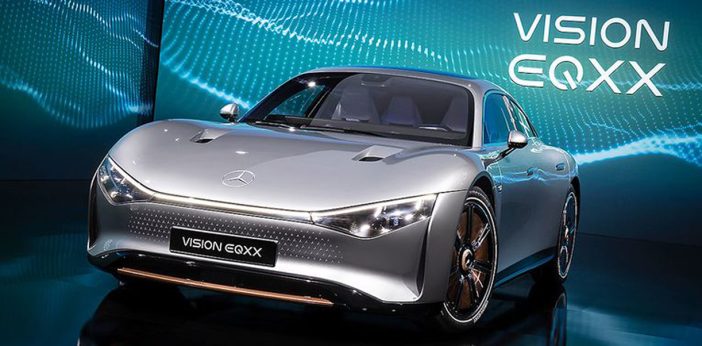
+++ The Cyberster roadster will arrive before 2024 as an affordable halo car for MG and one of three new models arriving by that date. It will build on the Chinese brand’s recent phenomenal success in Europe. The MG 4 hatchback will arrive first, before the end of this year. The value-driven rival to the Volkswagen ID 3 is expected to become MG’s biggest seller beside (or even surpassing) the MG ZS small SUV. MG commercial director Guy Pigounakis said of the MG 4: “The car stays true to our values of getting more from an MG. It represents cutting-edge technology, it needs to be exciting and it needs to represent fantastic value for money. That doesn’t mean cheap”. He added, in reference to the ZS EV’s 400 km range, that the MG 4 will “be even more competitive on a pound per mile of range basis than today” but said pricing for the family hatchback has yet to be decided. A production version of the Cyberster, first revealed as a concept at the Shanghai motor show last year, is likely to be shown at this year’s Beijing motor show in April, given MG’s history of showcasing new models at major Chinese events. The concept was said to be based on a bespoke EV architecture, offering a range of 800 km and a 0-100 kph time of less than 3.0 seconds. Talking about adding the Cyberster to the MG line-up, Pigounakis said: “The problem with sports cars is that everybody loves them but not many people buy them”. He added, however, that MG’s global volume means it can “afford to invest in sports cars and take a longer-term view on when there will be a return on investment”, adding that having a sports car “will bring us massive PR and marketing benefits”. The third new MG to arrive by 2024 hasn’t yet been confirmed, but it is likely to be a third SUV, given the continuing consumer demand for high-riding vehicles. +++
+++ The new GR Corolla will be officially revealed overnight, but new details published early by TOYOTA confirm it will use a heavily uprated version of the GR Yaris’s powertrain. The long-awaited entry to Toyota’s expanding Gazoo Racing performance line-up has previously been shown wearing the division’s trademark multicoloured camouflage and with its overall design mostly obscured from view, but these latest images show it completely unwrapped. It features a much more aggressive body design in line with its performance billing, with an expansive front grille, new bonnet vents, a chunky rear spoiler, flared arches and triple-exit exhausts the most obvious differentiators over the standard Toyota Corolla. Performance alloy wheels and beefy brakes round out the visual overhaul, but unlike the hot Yaris it retains a pair of rear doors. It uses the same powertrain as its Yaris sibling, but with power hiked up from 258 hp to 300 hp, making this more a rival to the Volkswagen Golf R than the Volkswagen Golf GTI, and torque has been boosted slightly, too, to 380 Nm. Power is sent to both axles through a 6-speed manual gearbox, as in the GR Yaris, with an IMT (intelligent manual transmission) function which essentially serves as a rev matching function for smoother downshifts. Meanwhile, torque vectoring functionality can vary power across the axles from 50/50 to 30/70 either way, to optimise traction in all conditions. Toyota has yet to confirm performance details of the GR Corolla, but a 0-100 kph time nudging 5.0 seconds looks to be well within reach. A European launch has not been confirmed. All teasers (and these latest details) so far have come from the US, where the GR Yaris is not available, following the withdrawal of the standard Yaris from that market. More details will be given at the debut later tonight. +++
